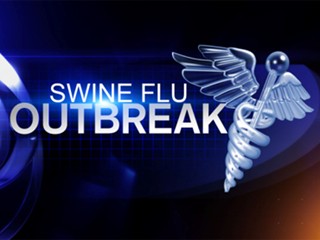
Last Wednesday, we published the first part of an interview we did with Dr. Brad Johnson, Vice President of Emergency Services for Mercy Health System of Northwest Arkansas on what has become one of the biggest health topics in the world — Swine Flu (also called the H1N1 virus).
Last week’s article included info on the symptoms of swine flu, how they differ from regular flu, who is at most risk and what symptoms indicate a need for urgent medical attention. If you missed the article, click here to see it.
The following is the continuation of last week’s interview and will give you lots of info on how this virus is spread, info on testing, vaccines, treatments and — most importantly — prevention. The article is a compilation of comments from Dr. Johnson as well as information found on the website of the Centers for Disease Control. As always, use this article for informative purposes only and always ask your own doctor for medical advice that is best for you.
How is the swine flu spread?
It appears to be spread as most viruses are spread. It spreads between humans through coughing or sneezing and people touching something with the virus on it and then touching their own nose or mouth. These secretions are often aerosolized by sneezing and coughing or spread by touching something that has the secretions on it. That’s why it’s so important to wash your hands often and cover your mouth when sneezing and coughing. Be careful not to touch your face without first washing your hands so that you don’t unknowingly “inoculate” yourself with the virus.
How long can the swine flu incubate in the human body?
The Swine Flu in humans is most contagious during the first five days of the illness, although some people — most commonly children — can remain contagious for up to 10 days.
How long can swine flu virus live on household surfaces?
Droplets from a cough or sneeze can also contaminate surfaces, such as a doorknob, drinking glass or kitchen counter, although these germs likely don’t survive for more than a few hours. (Enlarged photo of the virus is shown at right.)
Can doctors test patients for the swine flu? What type of test is it?
Patients can be tested for swine flu, but it’s a “send-out test” done by the health department. If you or your child has symptoms of the flu or there is a concern specifically for swine flu, your family doctor or pediatrician may do a rapid flu test to see if there is a presence of influenza Type A infection. If you don’t have a rapid test that’s positive for influenza A, then you probably don’t have swine flu.
Simplistically, Influenza A is a family of viral infections and swine flu is in that same family. To specifically determine if it’s swine flu, further testing can then be done to see if it’s a swine flu infection. (Samples can be sent to local and state health departments and the CDC for confirmation of swine flu.)
Can kids get a swine flu vaccination? At what age?
Yes, kids can get a vaccination after 6 months of age. (Contact your doctor’s office to find out when the vaccine will be available to you and your kids.)
What are the available treatments for swine flu?
Anti-flu medications including Tamiflu and Relenza are available to prevent and treat swine flu.
What are the most effective ways to prevent catching the swine flu?
Preventing the spread of this virus is similar to preventing any type of virus. Prevention steps include  washing your hands and your kids’ hands frequently with soap and water or with alcohol-based hand sanitizers, especially after being out in public. Chance of transmission is also reduced by disinfecting household surfaces with a diluted chlorine bleach solution.
washing your hands and your kids’ hands frequently with soap and water or with alcohol-based hand sanitizers, especially after being out in public. Chance of transmission is also reduced by disinfecting household surfaces with a diluted chlorine bleach solution.
Influenza can spread through coughs and sneezes, but evidence also shows that small droplets containing the virus can linger on tabletops, telephones and other surfaces and be transferred via the fingers to the mouth, nose or eyes. Wipe down surfaces regularly and use alcohol-based gel or foam hand sanitizers to help destroy viruses and bacteria.
Anyone with flu-like symptoms such as a sudden fever, cough or muscle aches should stay away from work, school or public transportation and should see a doctor.
Social distancing is another preventative tactic. It means staying away from other people who may be infected and include large gatherings, spreading out a little more at work or perhaps staying home if an infection is spreading in a community. Public health authorities have action plans which may request or require social distancing actions depending on the severity of an outbreak.
Our thanks to Dr. Brad Johnson of Mercy Health System for help in understanding the truth about swine flu. Dr. Johnson pointed out that, during newsworthy events like a potential swine flu outbreak, we’re often bombarded with information from a variety of sources — much of which is inaccurate and can create an unnecessary scare. He said people should consult www.cdc.gov as the definitive source of information about this virus.






